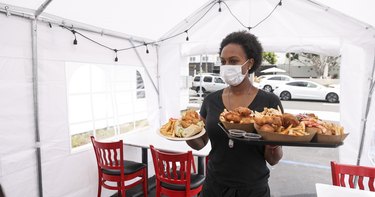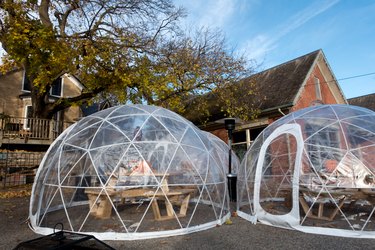
During the pandemic, outdoor dining — which poses lower COVID-19 transmission risk than eating indoors — has become increasingly popular. But now that winter weather has ushered in chillier temperatures, restaurants have begun to enclose these outside areas to keep diners warm and cozy.
Sure, these enclosures may shield you from the elements, but are they actually any safer than indoor dining?
Video of the Day
Video of the Day
We spoke to experts to understand the risks of outdoor tents, igloos and bubbles, plus ways to mitigate them if you choose to eat in one of these enclosures.
Tip
If you choose to dine out, wear a mask as much as possible, use hand sanitizer frequently and only break bread with people in your household. Still, the safest way to avoid catching (or spreading) COVID-19 and to support your local restaurants is by ordering takeout.
How Safe Are Outdoor Dining Igloos, Bubbles and Tents?
"As enclosed outdoor options begin to resemble indoor dining, the advantage of outdoor dining will diminish," Amesh Adalja, MD, a senior scholar at the Johns Hopkins University Center for Health Security, tells LIVESTRONG.com.
In other words, if you build a roof and four walls around an outdoor space, it essentially becomes an indoor one. The problem is that being inside — where there's no natural airflow — increases transmission risk.
And when you eat inside an outdoor enclosure, you're often in close proximity to others, breathing the same air and not wearing masks, says Max Sherman, PhD, residential team leader for the Epidemic Task Force at ASHRAE, a leading global authority on sustainable technology for the built environment.
Remember, COVID-19 spreads mainly through respiratory droplets when an infected person coughs, sneezes or talks within six feet of another. What's more, if the virus becomes airborne, it can reach distances further than six feet and hang around in the air for minutes to hours, per the Centers for Disease Control and Prevention.
Here's how to lower your COVID risk.
Get tips on how to stay healthy, safe and sane during the novel coronavirus pandemic.
1. Opt for Open Air
"The more open the outdoor space is, the safer it will be," Dr. Adalja says. Here's why: when there's a lot of fresh air circulating, contaminants such as viruses tend to disperse or become diluted. And that means a lower chance of infection.
So, if you have the choice of dining at an enclosure with a roof and four walls or an airy space that's less confined (think: just one or two walls to block wind), bundle up and go for the latter.
Just make sure your table is situated at least six feet from other diners, as social distancing is still essential for disease prevention, even outdoors, Dr. Adalja says.
2. Individual 'Igloos' Are Ideal

When open-air options are limited, individual bubbles or igloos — which sit only one party of restaurant patrons — are best.
"This isolation drastically reduces the chances of infection from other parties of diners and is a big improvement over standard indoor dining," Sherman says.
But these advantages apply mostly if you're dining with people you live with — when there's only one family per igloo, your risk is little different than if you were eating at home, Sherman says.
Conversely, if the number of parties within an igloo or tent is more than one — and people are not from the same household — your risk is more like that of indoor dining, Dr. Adalja says.
Similarly, "the presence of a server increases the risk because there is usually no easy way to social distance, especially in a bubble," Sherman says.
Fortunately, various safety protocols — such as wearing masks and frequent hand-washing — can be used to minimize spread between staff and customers, he adds.
3. Choose Well-Ventilated Enclosures
While good ventilation alone isn't sufficient to stop the spread of COVID-19, it can help decrease transmission rates, according to the Environmental Protection Agency (EPA).
Though a breeze might make you bristle in colder temps, a draft could indicate that an enclosure has fresh air circulating. "Things like tents tend to be pretty leaky and thus may get sufficient ventilation without an explicit ventilation system," Sherman says.
Still, that may not be enough for COVID protection, especially if the space is packed with patrons. To make spaces safer, restaurants should install some kind of mechanical ventilation. "An excellent system would be to 'inflate' the bubbles with heated, filtered outdoor air," Sherman says.
But even a portable, ducted supply fan — minus the filtering capabilities — could still be useful to improve airflow, Sherman adds. "Such a ventilation system would be visible (and likely hearable) with air coming in through a duct into the bubble somewhere."
However, even though these enclosed spaces may enjoy more air circulation than an indoor setting, keep in mind that your COVID risk is not as low as eating in the open air, Dr. Adalja points out.
4. Look for an Air Filtration System
While a mechanical ventilation system like a fan may be easy to spot, what's less obvious is whether the air is being filtered for COVID, Sherman says. Scan the space (or ask restaurant staff) to determine whether there's an air filtration system — like a portable air purifier — in use.
In combination with other safety measures like social distancing, mask wearing and good hand hygiene, air purifiers can also help reduce your transmission risk by bringing down the number of airborne contaminants, including viruses like COVID-19, in an enclosed environment, per the EPA.
5. Make Sure the Restaurant Disinfects Between Guests
Frequently sanitizing enclosed outdoor spaces can help keep you safe too.
"[Individual] bubbles should be sanitized between uses," says Sherman, adding, "this can be done relatively quickly with UV light, hydrogen peroxide generators or a variety of similar disinfection mechanisms."
If you're not sure about a restaurant's disinfection procedures, you can always call and inquire in advance of dining.
Concerned About COVID-19?
Read more stories to help you navigate the novel coronavirus pandemic:
Is this an emergency? If you are experiencing serious medical symptoms, please see the National Library of Medicine’s list of signs you need emergency medical attention or call 911.